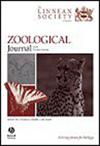Osteology and relationships of the Late Triassic giant dicynodont Lisowicia
IF 3
2区 生物学
Q1 ZOOLOGY
引用次数: 0
Abstract
Unexpectedly abundant remains of herbivorous therapsids in the Late Triassic strata of southern Poland have significantly supplemented knowledge of their evolution. The skeletal morphology of the Late Norian (or Rhaetian) dicynodont Lisowicia bojani supports its close relationship to the Carnian Woznikella, both known from the Polish part of the Germanic Basin. Three evolutionary lineages of dicynodonts—Laurasian–Gondwanan Rhadiodromus klimovi → Jachaleria candelariensis lineage, Laurasian lineage Shaanbeikannemeyeria xilougouensis → Lisowicia bojani, and the Gondwanan lineage Kannemeyeria simocephalus → Dinodontosaurus brevirostris—are distinguished based on characters of cranial and postcranial elements. In the lineages characterized by the parietal oval in cross-section and the two distinct articulations on the sternum, there is a tendency to exclude the frontal from the orbital margin and to reduce the number of sacral vertebrae. In the lineage with the parietal narrow and triangular in cross-section, the frontal forms part of the orbit margin, there is a single joint on the sternum, and there is a tendency towards flattening the skull roof. In both lineages the shoulder girdle is convergently modified, the acromion process decreased, and joints on the sternum moved posteriorly.三叠纪晚期巨型双齿龙 Lisowicia 的骨骼和关系
波兰南部晚三叠世地层中意外发现的大量草食性兽脚类遗骸极大地补充了人们对其演化的认识。晚纪(或雷蒂纪)双齿兽Lisowicia bojani的骨骼形态证实了它与卡年Woznikella的密切关系,这两种双齿兽都产自日耳曼盆地的波兰部分。根据颅骨和后颅骨的特征,区分了双齿龙的三个演化世系--劳拉西亚-冈瓦纳Rhadiodromus klimovi → Jachaleria candelariensis世系、劳拉西亚Shaanbeikannemeyeria xilougouensis → Lisowicia bojani世系和冈瓦纳Kannemeyeria simocephalus → Dinodontosaurus brevirostris世系。在以顶骨横截面为椭圆形、胸骨上有两个明显的关节为特征的世系中,人们倾向于将额骨从眶缘排除,并减少骶椎的数量。在顶骨横截面呈三角形的这一世系中,额骨构成了眼眶边缘的一部分,胸骨上只有一个关节,颅顶有变平的趋势。在这两个世系中,肩带都发生了收敛性改变,肩峰突减少,胸骨上的关节向后移动。
本文章由计算机程序翻译,如有差异,请以英文原文为准。
求助全文
约1分钟内获得全文
求助全文
来源期刊
CiteScore
6.50
自引率
10.70%
发文量
116
审稿时长
6-12 weeks
期刊介绍:
The Zoological Journal of the Linnean Society publishes papers on systematic and evolutionary zoology and comparative, functional and other studies where relevant to these areas. Studies of extinct as well as living animals are included. Reviews are also published; these may be invited by the Editorial Board, but uninvited reviews may also be considered. The Zoological Journal also has a wide circulation amongst zoologists and although narrowly specialized papers are not excluded, potential authors should bear that readership in mind.

 求助内容:
求助内容: 应助结果提醒方式:
应助结果提醒方式:


